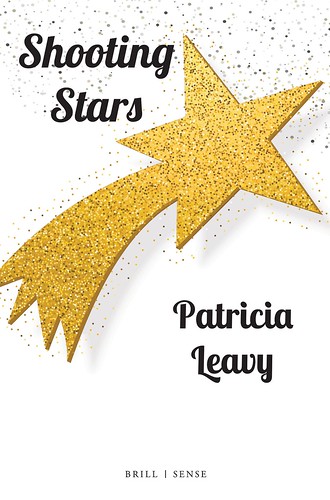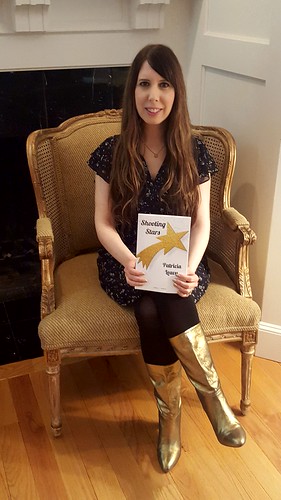Read This: Why Shooting Stars is One of the Most Important Books You’ll Ever Read
One of our favorite writers, Patricia Leavy, is back with a novel that is one of the most important books you’ll ever read. Shooting Stars is one of those books that, once you start, you cannot put down (yes, 4am bedtime, but happy!).
It’s a story of courage, chosen family, and how love–in all aspects–can help heal and grow. It has stayed with me, and I cannot stop thinking about the themes, characters, and how we all need more of this goodness in our lives. Read this...you'll be SO glad you did. And then, like me, you'll recommend it to everyone you know. Good things are like that–you share.

We were lucky enough to catch up with Leavy, and ask about Shooting Stars, writing, and more. Here’s what she had to say…

Please tell us about your new novel, Shooting Stars...
At the core, it’s a love story. In the first chapter, Tess Lee, a successful inspirational novelist, and Jack Miller, a federal agent, meet in a bar. Their connection is palpable. Later that night, she examines the scars on his body and says, “I’ve never seen anyone whose outsides match my insides.”
The two embark on an epic love story that asks the questions: What happens when people truly see each other? Can unconditional love change the way we see ourselves?
Their friends are along for the ride, and through these relationships we see love in many different forms.
Shooting Stars is a novel about walking through our past traumas, moving from darkness to light, and the ways in which love–from lovers, friends, or the art we experience–heals us. I’ve written it as unfolding action, no interiority or flashbacks, so readers experience the characters as they experience each other. Tonally, the book moves between melancholy, humor, and joy. It’s ultimately uplifting and a love letter to love itself.
What inspired you to write this book?
I really wanted to explore love in its many forms and textures—coziness, joy, pain, humor, comfort, intimacy, compassion. Beyond that, I wanted to look at love and healing. Few people escape this life without pain, even if it’s not the intense forms of trauma and grief these characters have experienced, and I doubt any of us don’t know people who have suffered great losses.
How can we love and care for one another? What does that look like in day to day life? How can we honor each other by truly seeing one another? How does being seen change how we see ourselves? These questions inspired me.
Like many of your novels, popular culture and art are part of the narrative. Please talk about this.
I used popular culture and art in two different ways to help tell this story. There are pieces of art that hold special meaning to the characters, help set the tone of scenes, and move the plot forward. These include songs and films. The most noteworthy example is the film Moulin Rouge which is special to the protagonist, Tess. The references are fleshed out enough for readers who may not have seen the film. Through Tess’s connection to this film, we come to learn important things about her, from her deeply caring relationship with Omar, her closest friend, to her traumatic childhood and dreams for herself. Another way that art is central to the narrative is through Tess’s writing. She’s a world-famous novelist that has been dubbed by the media “the people’s high priestess of pain” because of the difficult topics she tackles in her books as well as her honest and raw writing style. Really, her books are inspirational. They help guide people from darkness to light. We learn about the impact of her work in various ways including encounters with her fans. She also recites an excerpt from one of her novels, which is meant to mirror themes in Shooting Stars. Each Tess Lee and Jack Miller novel will include an excerpt from a Tess Lee novel, meant to reflect or summarize the themes in the novel I have written.
This is your first novel set in Washington, D.C.. Why did you choose this setting?
Jack is an agent with the FBI, so D.C. was a natural home for the book. There were other considerations, too. At the core, the novel is about deeply personal matters, but there is always another side, because the personal is political. Whether we’re dealing with issues of sexual assault or some of the other issues that arise in the book, there’s a critical political side. So while that isn’t directly explored in the novel which focuses on personal stories, I wanted to have the novel set in D.C. as a subtle nod to that other side of the story. D.C. becomes even more important in the second Tess Lee and Jack Miller novel, when Tess befriends the female president of the United States.
As with all your fiction, Shooting Stars can be used in the classroom in a range of college courses? How can educators use this book to teach?
I’m a sociologist, and I wrote Shooting Stars with the hopes it would be used to stimulate reflection and discussion in a range of courses in sociology, psychology, social work, communication, and other disciplines. It can be used to address topics including but not limited to interpersonal relationships, love, trauma, healing, marriage and families, and gender. It’s a short book so it can easily be integrated into courses. At the end of the novel, there are discussion questions as well as writing, research, and art activities to assist professors who wish to incorporate it into their classes. The further engagement is merely meant to stimulate ideas about any number of ways the novel might be integrated into courses.
The novel also includes an author Q&A which might provide useful in classroom or book club settings. Students often enjoy reading fiction and engage with the ideas presented differently than they might with nonfiction. Fiction also fosters empathetic understanding. I think there’s tremendous value in that for the learning experience.
All of my previous works of fiction have been used in college classes, but I particularly hope professors use Shooting Stars as required reading, in part because the characters in the book are wonderful role models in so many ways. They’re good people. They’re trying to make the world better. They show what love and caring look like in action, out in the larger society and in our most intimate relationships. They’ve gone through difficult challenges, and most people can relate to that, but they’ve built beautiful lives and relationships. I’d love to see college students read a novel that’s based on these hopeful, aspirational characters.
What does Shooting Stars offer for the general reader?
This novel is truly meant for anyone. It shows how a couple of people make the journey from darkness to light. I think that’s something we can all relate to. There are messages I think anyone can benefit from. Healing is possible. Love is possible. Healing is possible if we let love into our lives, whether that love comes from friends who get us, lovers who truly see us, or the art we make or experience, like a song, a movie, or even a novel. Mostly what I’ve heard, from early readers and reviewers who have been extraordinarily generous, is that they loved the characters and couldn’t put the book down, and it lingered long after the last page. It’s a quick read. I envision people who want to read it in one sitting getting cozy in a comfy chair, entering this story world, and letting the characters embrace them in a big hug.
What's up next for you? Shooting Stars indicates there will be more Tess Lee and Jack Miller novels, which you mentioned earlier.
Sometimes when I complete a novel, I feel like I can say goodbye to the characters because I’ve told their story. Other times, I know the next chapter. That was the case with this book more than anything I’ve done before, largely because I’m so in love with the characters.
After completing Shooting Stars, I spent one day feeling a deep sense of loss. The next day, I started on book two. Five books have been written in total, each taking place a year after the previous one. Each Tess Lee and Jack Miller novel explores love at the intersection of another theme; in Shooting Stars, the theme I explore is love and healing. The next book explores love and doubt.
By the time we move through the series, the major issues that I think plague our relationships, including the one we have with ourselves, are addressed. As the characters move through them toward greater healing, connection, and joy, I hope readers do as well.
The series as a whole is a love letter to love, in all its forms. These novels came from the deepest part of my soul and I love them in a way that’s hard to explain. Out of my entire body of work, this serial is what I’m most proud to leave behind. I hope these novels bring others a bit of the joy, coziness, catharsis, and inspiration that they’ve given me. They’ve embraced me in a big, warm hug. I hope they do that for others.
Here's our interview with Leavy for the second book in this series (YAY!): Breathe Into Love: Twinkle is Already the Must-Read Book of the Year
Wandering Educators spotlight on Leavy’s books:
Write This: Author Patricia Leavy on Setting, Inspiration, and Teaching in her New Novel, Film
Read This: Inspiration, Joy, and Life in Patricia Leavy's SPARK
Read this: Living a Big Life in Patricia Leavy’s Candy Floss Collection
Blue: Identity, Self, and Possibility
More information:
Patricia Leavy, Ph.D., is an independent sociologist and best-selling author. She has published more than 30 books, earning critical and commercial success in both nonfiction and fiction and her work has been translated into numerous languages. She is also the creator and editor for ten book series with Oxford University Press, Brill-Sense, and Guilford Press, the co-founder and co-editor-in-chief of Art/Research International: A Transdisciplinary Journal, and a blogger for numerous outlets. She is most widely known for her work advancing arts-based research and pioneering the social fictions concept and book series. Patricia has received numerous book awards as well as career awards from New England Sociological Association, the American Creativity Association, the American Educational Research Association, the National Art Education Association, and the International Congress of Qualitative Inquiry. In 2016 Mogul, a women’s empowerment network, named her an “Influencer.” In 2018, she was honored by the National Women’s Hall of Fame and the State University of New York-New Paltz established the “Patricia Leavy Award for Art and Social Justice.”
Her website is www.patricialeavy.com
Facebook: https://www.facebook.com/WomenWhoWrite/
Instagram: https://www.instagram.com/patricialeavy
Buy Shooting Stars on Amazon:
https://www.amazon.com/dp/900443934X
Buy Shooting Stars from the Publisher (Brill):
https://brill.com/view/title/58920
-

- Log in to post comments


















